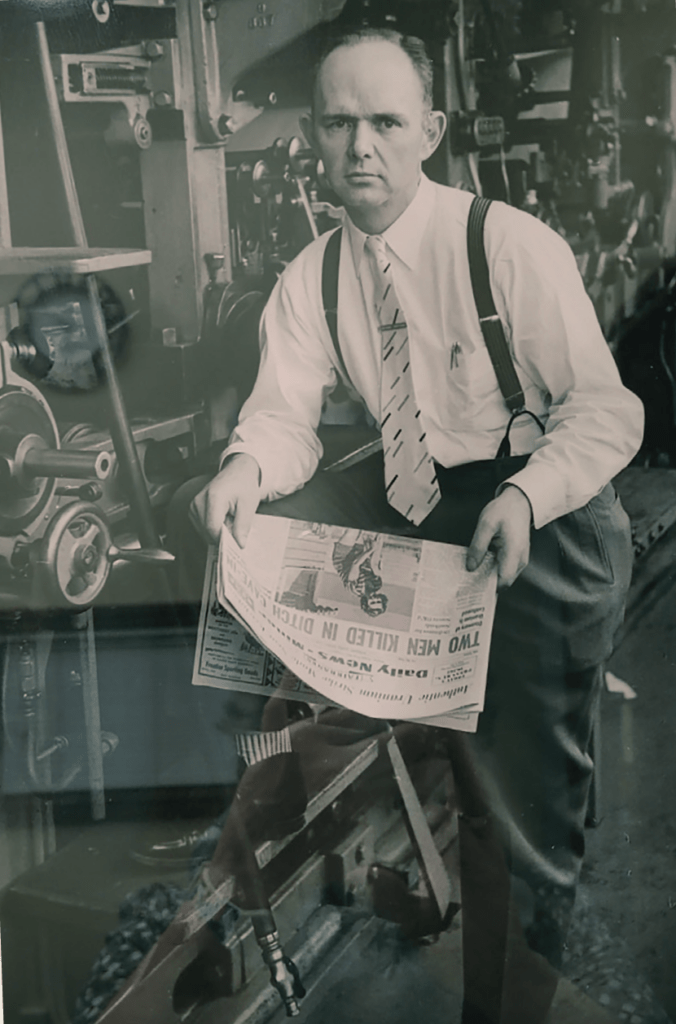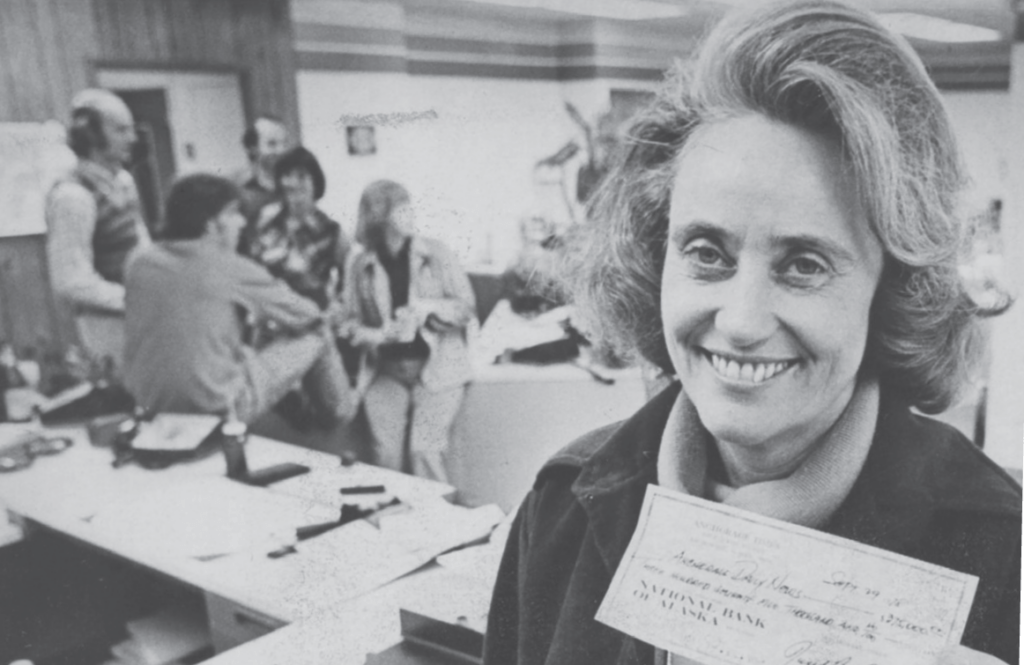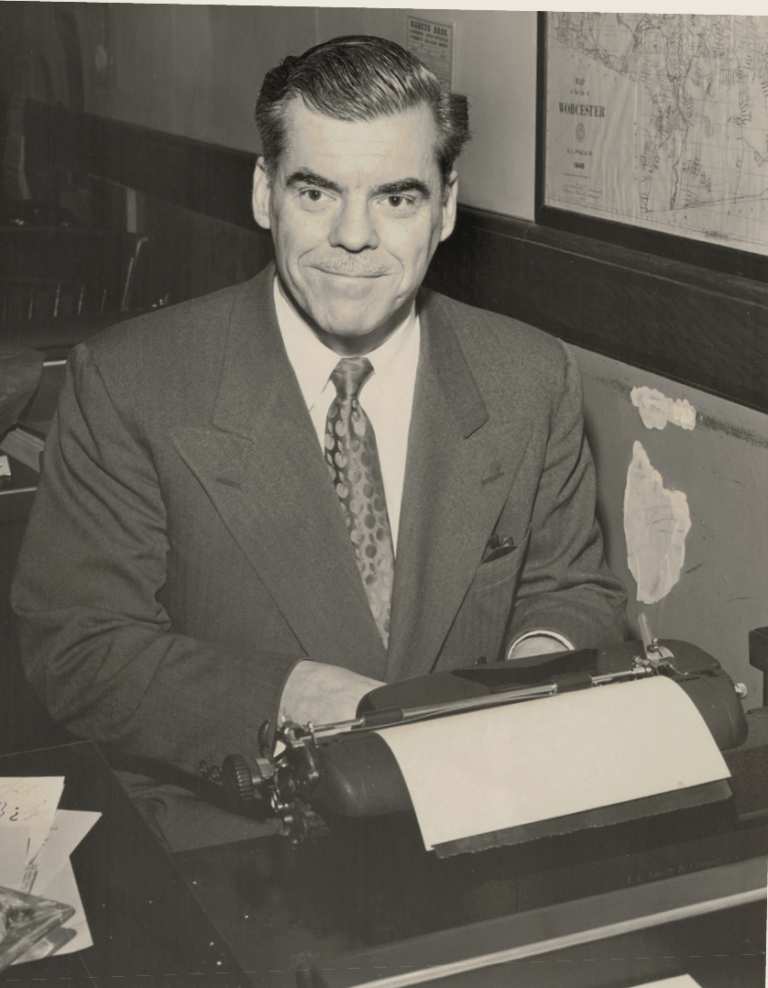A colorful history of Alaska’s newspaper industry
Above: Bob Atwood, publisher of the Anchorage Times: Courtesy of the Atwood Foundation
Alaska has a legacy of bigger-than-life media personalities who ruled the presses like old-fashioned newspaper barons. They include Bob Atwood, publisher of the Anchorage Times; Kay Fanning, publisher of the Anchorage Daily News, C.W. “Bill” Snedden, publisher of the Fairbanks News Miner, Howard Rock, editor of the Tundra Times and Alice Rogoff, publisher of the short-lived Alaska Dispatch News. They all had a vision for Alaska, whether it was statehood, rights for Alaska Natives, or Alaska leading the world in Arctic research and innovation.
Alaskan publishers dealt with climate extremes that newspapers in other states did not have. Everything from newsprint to printing presses had to be brought up by barge. Alaska wasn’t even a state during some of their tenures. Nevertheless, they produced award-winning journalism including three Pulitzers won by the Daily News in 1976, 1989, and 2020.
Oldest of the barons was Bob Atwood, who moved to Alaska in 1935 along with his new wife, Evangeline Rasmuson, the daughter of Edward Rasmuson, one of Alaska territory’s most prominent bankers. Alaska, Atwood would say, was seen in the same light as Americans consider present-day Guam: out of sight and far away. He borrowed $10,000 from his father-in-law and bought what was then the Anchorage Daily Times. It was an afternoon paper because its owners considered Alaska mornings too cold and dark to deliver papers.

Atwood helped lure military installations to the territory; a move that was helped immensely by the advent of World War II. He proposed a city manager form of government for Anchorage, but his one major defeat was a campaign to move the state’s capital from Juneau to a spot north of Anchorage.
Atwood’s biggest campaign was for statehood from 1943 to 1959. He wrote more than 250 editorials on the topic. When Congress voted Alaska as the 49th state on June 30, 1958, the Times ran “WE’RE IN” in seven-inch-high type. When President Dwight Eisenhower signed the statehood bill six months later, Atwood stood beside him, receiving one of the six pens the president used.
One of the men who should have been standing there with him was C.W. “Bill” Snedden, publisher of the Fairbanks News Miner. Founded in 1903, the News Miner—along with the Nome Nugget and the Wrangell Sentinel—was one of three surviving Alaska papers from the 1890s Klondike gold rush. Snedden arrived in Fairbanks from Washington state in 1950 to help repair a linotype machine at the newspaper and ended up buying the publication. The construction of the Alcan highway in 1942 had brought to Fairbanks Alaska’s only overland link to the Lower 48, plus two military bases into which the Department of Defense poured $100 million a year. The region’s population had quadrupled between 1940 and 1950, as Fairbanks was the only major city within a 227,000-square-mile area.

By the late 1950s when the statehood battle came down to the wire, Snedden was putting in personal calls and letters to the editors of Life and Time magazines, the New York Times, and the New York Herald-Tribune. Most helpful was William Randolph Hearst, Jr., who threw the weight of his entire newspaper chain behind statehood and ran editorials in newspapers located in states of anti-statehood politicians. Snedden also had huge influence among Republicans so that when the final vote was tallied in the Senate, more Republicans (33) than Democrats (31) voted for the admission of Alaska.
Snedden also took the lead in the push to modernize downtown Fairbanks, build a community-owned hospital, a local oil refinery, and a city-owned electric and phone system. He also took on a protégé; a lawyer named Ted Stevens who was 10 years his junior. Snedden acted as a guide and life coach to Stevens, who would become one of the most influential politicians ever to hold office in Alaska and the longest serving (41 years) Republican in the U.S Senate.
A second newspaper birthed out of Fairbanks came from a group of determined Alaska Natives who wanted a paper that represented them. Howard Rock, an Inupiat artist and a village spokesman for Point Hope, was approached by the Arctic Slope Native Association to start one. With the help of a News Miner reporter, Tom Snapp, Rock published The Tundra Times on Oct. 1, 1962. The Tundra Times was instrumental in the fight for the Alaska Native Land Claims Settlement of 1971 as it gave Natives a voice in how their ancestral lands should be used. The settlement also laid the foundation for the trans-Alaska pipeline that was built in the 1970s and which loosened America’s dependence on foreign oil. Howard Rock and Ted Stevens shared an “Alaskan of the Year” award in 1974, and the newspaper was nominated for (although it didn’t win) a Pulitzer in 1975 for public service. Rock died in 1976, and the newspaper folded in 1997.

Meanwhile Kay and Larry Fanning had bought the Anchorage Daily News. The press was 75 years old; the old linotypes were in terrible condition, and just about everything else was obsolete. Plus, they were up against Bob Atwood’s Anchorage Times.
The two newspapers were polar opposites. The Times focused on business, oil, politics, and the military, whereas the News had edgier coverage of controversies such as abortion, minorities, the poor, and Native culture. The way Fanning saw it, Atwood was not a journalist but simply a community builder who happened to own a newspaper. Atwood, for his part, didn’t think the News’ liberal new owners had the pulse of Alaska.
After Larry Fanning died of a heart attack in 1971, his wife continued on, but within a few years, her newspaper was $750,000 in debt and down to about 7,850 in circulation. The Times and the News signed a joint operating agreement in 1974 to reduce costs, but three years later, Fanning sued the Times for breach of contract. The Times countersued.
As the News continued to run low on funds, Fanning sought out the owners of the California-based McClatchy newspaper chain and offered to sell them the paper. Anchorage was a high-growth place at the time; construction on the $9 billion oil pipeline was at its height, and the state was flush with money. On Jan. 17, 1979, McClatchy bought the News, poured money into it, and eventually drove the Times out of business in 1992.

About a decade later, Alice Rogoff, wife to billionaire financier David Rubinstein, visited the state and became enamored of it. In 2009, she snapped up a local news site, AlaskaDispatch.com, then five years later combined it with the News, which she bought from McClatchy for $34 million, way more than the paper was worth.
Rogoff immediately got the Dispatch involved in Alaska-centric causes. One of her pet projects was to get the state to develop its 2,000-mile coastline along the Bering Sea with deep-water ports in Nome and Port Clarence, the two west coast towns most suited for major shipping. Her political capital soared as she hosted President Barak Obama for a private dinner at her lakeside mansion in Anchorage during the chief executive’s September 2015 visit.
Rogoff’s newspaper wasted little time in comparing her to Fanning, but in spirit, she was closer to Atwood’s business-first approach. However, she overspent—by millions of dollars—on the newspaper and ended up with one of the state’s more spectacular business failures. In the summer of 2017, she filed for bankruptcy, selling the newspaper to the Fairbanks-based Binkley Company.
All of these pioneers may not have stood out as much in the Lower 48. But Alaska gave them the canvas they needed to paint a vision for a quality of life for a state they believed would someday be key to the nation’s future.
Julia Duin was the Snedden Chair at the University of Alaska/Fairbanks journalism department from 2014-2015. In July 2015, she profiled Alice Rogoff for the Washington Post. She lives near Seattle.



Comments are closed.